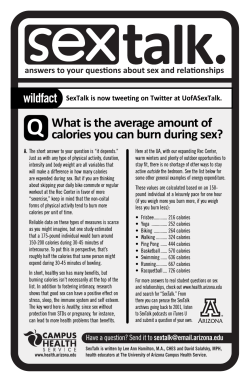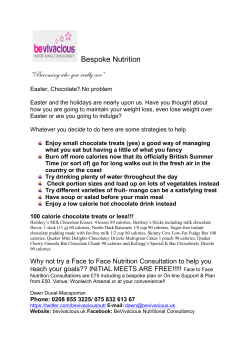
Personalized Fitness Plan!
“Bid me run and I will strive with things impossible.” -Shakespeare Julius Caesar Proven Benefits of Exercise Longer attention span Better memory Less stress/tension/anxiety Less chance of getting sick Height:______________________ Weight______________________ Fastest Mile__________________ Max Pushups_________________ Number of 30 min exercise sessions per week (not including PE!)_________________ Name__________________________________________ Date_____________________Period____________ More energy and motivation Improved mood Better sleep Healthier skin See a PE teacher or Mr. Kirkland after school for a complete fitness evaluation Body Fat %____________________ Bicep Strength_________________ Sit-and-Reach__________________ VO2Max______________________ Outline your typical school day below, including the time you wake up and go to bed. Wakeup Time: What do you do? Bed Time: Typical hours of sleep each night (should be 8-10): Where can you schedule at least 30 minutes of continuous exercise? What are some activities that you enjoy? Outline your week, including school and after-school activities. Then, pick at least five days where you can schedule 30 minutes of continuous exercise. Draw a heart to represent exercise. Describe each exercise, including the body system(s) being impacted, e.g. cardiovascular, musculoskeletal, nervous. Sunday Monday Tuesday Wednesday Thursday Friday Exercise + Body System(s) Used Exercise + Body System(s) Used Exercise + Body System(s) Used Exercise + Body System(s) Used Exercise + Body System(s) Used Exercise + Body System(s) Used Saturday Exercise + Body System(s) Used Write a food log for each category. Record the calories, fat, and sodium for each food item, then total them at the bottom. For homemade items, use myfitnesspal.com or calorieking.com/foods. For restaurant items, use the restaurant’s website. You must include at least two restaurants. B=Breakfast, L=Lunch, D=Dinner, C=Calories, F=Fat, S=Sodium Nutrition Nutrition Typical Weekday Goal Weekday Typical Weekend Information Information Nutrition Information Goal Weekend Nutrition Information C C C C F F F F S S S S C C C C F F F F S S S S C C C C F F F F S S S S Breakfast Lunch Dinner C C C Totals (Include F F F Snacks!) S S S *Use http://www.choosemyplate.gov/myplate/index.aspx to calculate your daily nutrition needs. C F S Only one in three children is physically active every day. Less than 5% of adults participate in 30 minutes of physical activity each day; only one in three adults receive the recommended amount of physical activity each week. Only 35 – 44% of adults 75 years or older are physically active, and 28-34% of adults ages 65-74 are physically active. More than 80% of adults do not meet the guidelines for both aerobic and muscle-strengthening activities, and more than 80% of adolescents do not do enough aerobic physical activity to meet the guidelines for youth. In 2013, research found adults in the following states to be most likely to report exercising 3 or more days a week for at least 30 minutes: Vermont (65.3%), Hawaii (62.2%), Montana (60.1%), Alaska (60.1%). The least likely were Delaware (46.5%), West Virginia (47.1%) and Alabama (47.5%). The national average for regular exercise is 51.6%. Children now spend more than seven and a half hours a day in front of a screen (e.g., TV, videogames, computer). Nationwide, 25.6% of persons with a disability reported being physically inactive during a usual week, compared to 12.8% of those without a disability. Only about one in five homes have parks within a half-mile, and about the same number have a fitness or recreation center within that distance. Only 6 states (Illinois, Hawaii, Massachusetts, Mississippi, New York and Vermont) require physical education in every grade, K-12. 28.0% of Americans, or 80.2 million people, aged six and older are physically inactive. Nearly one-third of high school students play video or computer games for 3 or more hours on an average school day. Typical American diets exceed the recommended intake levels or limits in four categories: calories from solid fats and added sugars; refined grains; sodium; and saturated fat. Americans eat less than the recommended amounts of vegetables, fruits, whole-grains, dairy products, and oils. About 90% of Americans eat more sodium than is recommended for a healthy diet. Reducing the sodium Americans eat by 1,200mg per day on could save up to $20 billion a year in medical costs. Food available for consumption increased in all major food categories from 1970 to 2008. Average daily calories per person in the marketplace increased approximately 600 calories. Since the 1970s, the number of fast food restaurants has more than doubled. In 2013, residents of the following states were most likely to report eating at least five servings of vegetables four or more days per week: Vermont (68.7%), Montana (63.0%) and Washington (61.8%). The least likely were Oklahoma (52.3%), Louisiana (53.3%) and Missouri (53.8%). The national average for regular produce consumption is 57.7%. Empty calories from added sugars and solid fats contribute to 40% of total daily calories for 2–18 year olds and half of these empty calories come from six sources: soda, fruit drinks, dairy desserts, grain desserts, pizza, and whole milk. US adults consume an average of 3,400 mg/day [of sodium], well above the current federal guideline of less than 2,300 mg daily. Food safety awareness goes hand-in-hand with nutrition education. In the United States, food-borne agents affect 1 out of 6 individuals and cause approximately 48 million illnesses, 128,000 hospitalizations, and 3,000 deaths each year. Source: http://www.fitness.gov/resource-center/facts-and-statistics/ Motivate yourself to eat healthy and exercise! Are you more motivated by scary statistics and fear, or by positive messages? Using all of the information you have gathered throughout our health unit, including Ted Talks, articles, and science lessons, design a poster that will get you up and moving! You may use online resources, but no, you cannot just copy/paste one of the million posters that are already on the internet. Write a 1-2 minute speech that argues against one or more of the statements below. You must include at least three references to our health unit resources (anything listed in your table of contents). I don’t have time to exercise. Eating healthy is too expensive. My knee hurts so I can’t exercise. But Hot Cheetos taste so good! A few Cokes a day won’t kill me. I hate getting all sweaty. It’s too hot outside to exercise. Cooking takes too long. I hate running. I’m not good at sports. ____________________________________________________________________________________________ ____________________________________________________________________________________________ ____________________________________________________________________________________________ ____________________________________________________________________________________________ ____________________________________________________________________________________________ ____________________________________________________________________________________________ ____________________________________________________________________________________________ ____________________________________________________________________________________________ ____________________________________________________________________________________________ ____________________________________________________________________________________________ ____________________________________________________________________________________________ ____________________________________________________________________________________________ ____________________________________________________________________________________________ ____________________________________________________________________________________________ ____________________________________________________________________________________________ ____________________________________________________________________________________________ ____________________________________________________________________________________________ ____________________________________________________________________________________________ ____________________________________________________________________________________________ ____________________________________________________________________________________________ ____________________________________________________________________________________________ ____________________________________________________________________________________________ ____________________________________________________________________________________________ ____________________________________________________________________________________________
© Copyright 2025

















